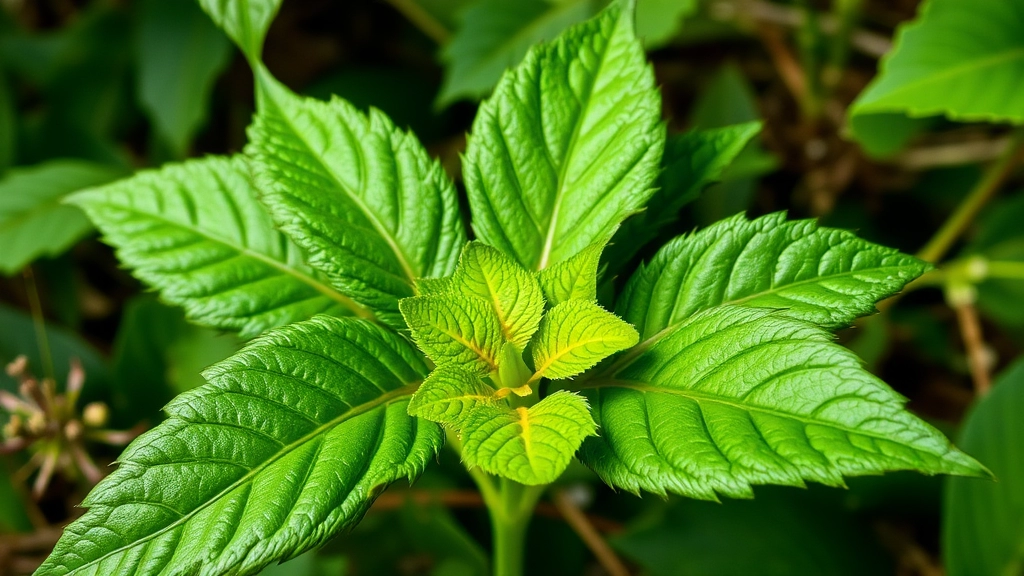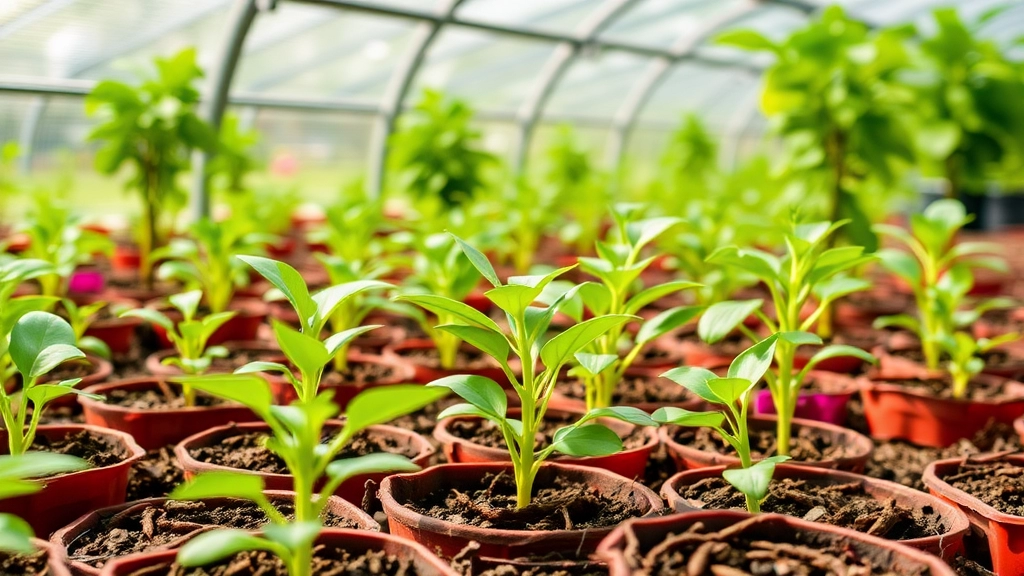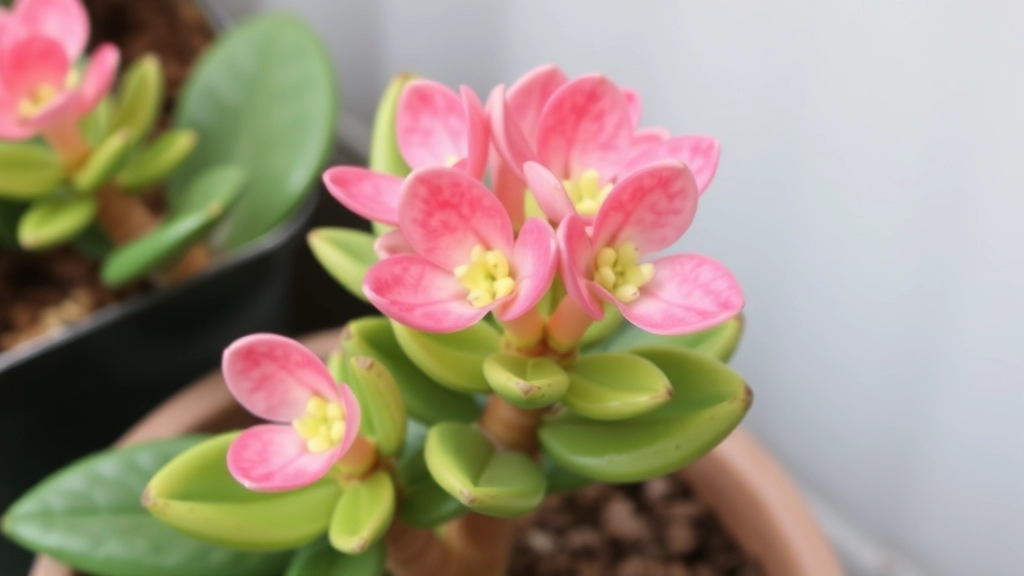Kalanchoe brasiliensis: The Brazilian Beauty
Kalanchoe brasiliensis, the Brazilian beauty of the succulent world, is about to become your new plant obsession. This resilient native of Brazil’s northeastern region isn’t just a pretty face – it’s a powerhouse of medicinal properties and a champion of adaptability. From its water-storing leaves to its cheerful blooms, this plant has captured the hearts of gardeners and herbalists alike.
Exploring Kalanchoe brasiliensis
In this article, we’ll dive deep into the world of Kalanchoe brasiliensis. We’ll explore its unique characteristics, uncover its medicinal secrets, and share expert tips on how to grow and care for this fascinating succulent. Whether you’re a seasoned plant enthusiast or a curious newcomer, get ready to discover why this Brazilian kalanchoe is making waves in gardens and traditional medicine cabinets around the globe.
Kalanchoe brasiliensis: The Brazilian Kalanchoe
Ever heard of Kalanchoe brasiliensis? It’s a pretty cool plant.
Let me break it down for you.
This succulent’s a native of Brazil (hence the name).
It’s part of the Crassulaceae family – fancy word for stonecrop plants.
Here’s the thing: it’s not just a pretty face.
Kalanchoe brasiliensis has some serious medicinal chops.
People have been using it for ages in traditional medicine.
But wait, there’s more.
It’s also a hit in gardens and as a houseplant.
Why? It’s tough as nails and looks great.
Plus, it’s got these funky leaves that store water.
Smart plant, right?
Now, don’t confuse it with its cousin, Kalanchoe blossfeldiana.
That’s the one you usually see in shops.
Kalanchoe brasiliensis is its wilder, more mysterious relative.
It’s got its own unique vibe.
So, whether you’re a plant nerd or just curious, this Brazilian beauty’s worth knowing about.
Stick around, and I’ll spill all the juicy details on Kalanchoe brasiliensis.
Botanical Characteristics

Alright, let’s dive into the botanical characteristics of Kalanchoe brasiliensis. This plant’s a real stunner, and I’m excited to break it down for you.
Kalanchoe brasiliensis: Nature’s Little Powerhouse
Ever seen a plant that looks like it’s straight out of a sci-fi movie? That’s Kalanchoe brasiliensis for you. This succulent’s got some seriously cool features that make it stand out in the plant world.
Leaf Structure: The Money-Maker
- Shape: Oval to oblong, like mini paddles
- Texture: Thick and fleshy, perfect for water storage
- Edges: Slightly scalloped or wavy
- Colour: Deep green, sometimes with a reddish tinge
These leaves are the plant’s secret weapon. They’re like built-in water bottles, helping the plant survive in tough conditions. Pretty smart, right?
Stem and Growth Habit: The Support System
The stems of Kalanchoe brasiliensis are sturdy and upright, giving the plant a bush-like appearance. It’s not a climber or a crawler – this plant stands tall and proud.
Flowers: The Show-Stoppers
When this plant blooms, it’s a real sight to behold:
- Colour: Usually yellow or orange
- Shape: Small and tubular
- Arrangement: Clusters at the top of the plant
These flowers aren’t just pretty – they’re like a beacon for pollinators. Bees and butterflies love ’em.
Size: Not Too Big, Not Too Small
In its natural habitat, Kalanchoe brasiliensis can grow up to:
- Height: 30-60 cm (1-2 feet)
- Width: Similar spread
It’s like the Goldilocks of plants – not too big, not too small, just right for many spaces.
Root System: The Hidden Hero
The roots of Kalanchoe brasiliensis are fibrous and shallow. They’re not deep divers, but they spread out to make the most of surface water. It’s a clever adaptation for a plant that often grows in rocky or sandy soils.
Kalanchoe brasiliensis is a plant that’s built to survive and thrive. Its unique botanical characteristics make it a fascinating subject for plant enthusiasts and a hardy choice for gardeners. Whether you’re looking at its water-storing leaves or its cheerful flowers, there’s always something interesting about this plant to discover. If you’re intrigued by the Kalanchoe family, you might also want to check out the Kalanchoe blossfeldiana family for more variety in your succulent collection.
Native Habitat and Distribution
Ever wondered where Kalanchoe brasiliensis calls home?
Let’s dive into its roots (pun intended).
This succulent’s a true Brazilian native.
It’s not just any part of Brazil, though.
We’re talking the northeastern region, mainly.
Think coastal areas and rocky outcrops.
These plants love soaking up that tropical sun.
But here’s the kicker:
They’re tough cookies, adapting to various climates.
You’ll find them thriving in:
- Dry, sandy soils
- Rocky hillsides
- Even in cracks of urban sidewalks!
They’re not picky, which is why they’ve spread.
Now, you’ll spot them in other parts of South America too.
Some have even made their way to Africa and Asia.
But Brazil? That’s where they shine.
It’s like they’re showing off in their home turf.
Remember, understanding their native habitat is key.
It helps us grow them better in our own gardens.
So, next time you see a Kalanchoe brasiliensis, think Brazil!
Cultivation and Care Tips

Alright, let’s dive into how to grow and care for Kalanchoe brasiliensis like a pro. Trust me, it’s not rocket science, but there are a few tricks up my sleeve that’ll make your life a whole lot easier.
Soil and Potting: What’s the Deal?
First things first, these succulents aren’t fussy eaters. They’ll do just fine in a well-draining potting mix. But here’s a pro tip: mix in some perlite or coarse sand. Why? It’ll stop water from hanging around too long and potentially rotting the roots. Nobody wants that drama.
Light: How Much is Too Much?
Kalanchoe brasiliensis loves the sun, but it’s not trying to get a tan. Bright, indirect light is the sweet spot. If you’re keeping it indoors, a south-facing window is perfect. Outside? Partial shade is your best bet. Just remember, too much direct sun can scorch the leaves. Ouch!
Watering: The Goldilocks Approach
Here’s where people often mess up. These plants are succulents, so they’re built for drought. Water them deeply, but then let the soil dry out completely before you go at it again. In winter, cut back even more. Overwatering is the fastest way to kill these beauties, so when in doubt, keep it dry.
Temperature: Keeping it Cozy
Good news: Kalanchoe brasiliensis isn’t too picky about temperature. It’ll be happy as Larry between 15-26°C (60-80°F). But here’s the kicker – it can’t handle frost. If you’re in a chilly area, bring it inside when temperatures drop below 10°C (50°F). Speaking of temperature, it’s worth noting that the Kalanchoe blossfeldiana temperature requirements are quite similar.
Fertilizer: Feed Me, Seymour!
During the growing season (spring and summer), give your plant a little boost with a balanced, water-soluble fertilizer. But don’t go overboard – once a month is plenty. In autumn and winter, let it rest. It’s like a little plant vacation.
Pruning: Snip Snip!
To keep your Kalanchoe brasiliensis looking its best, don’t be afraid to give it a haircut now and then. Pinch off any dead or yellowing leaves, and if it’s getting too leggy, trim it back. It’ll thank you by growing back bushier and healthier.
Repotting: Moving Day
Every couple of years, your plant might outgrow its home. When roots start peeking out of the drainage holes, it’s time for an upgrade. Choose a pot that’s just a size or two larger, and use fresh potting mix. Spring is the best time for this little relocation project.
Remember, growing Kalanchoe brasiliensis isn’t about perfection. It’s about understanding what makes this plant tick and giving it the basics it needs to thrive. Get these cultivation and care tips right, and you’ll have a happy, healthy plant that’ll be the envy of your green-thumbed mates. If you’re interested in other Kalanchoe varieties, you might want to check out the types of Kalanchoe tomentosa as well.
Medicinal Uses and Benefits
Kalanchoe brasiliensis: Nature’s Secret Weapon?
Ever wondered if plants could be your personal health guru? Well, Kalanchoe brasiliensis might just be that green superhero you’ve been looking for.
Let’s dive into the good stuff this plant’s packing:
Anti-inflammatory Superstar
- Soothes aches and pains
- Helps with arthritis and joint issues
- Reduces swelling like a champ
Wound Healing Wonder
- Speeds up skin repair
- Fights off nasty bacteria
- Great for cuts, burns, and bruises
Respiratory Relief
- Eases coughs and congestion
- Helps with asthma symptoms
- Clears up those stuffy airways
Digestive Aid
- Settles upset stomachs
- Reduces bloating and discomfort
- Might even help with ulcers
Immune System Booster
- Packed with antioxidants
- Helps fight off pesky infections
- Keeps your body’s defences strong
But here’s the kicker: it’s not just old wives’ tales. Scientists are actually digging into this plant’s potential.
They’re finding some pretty exciting stuff about how it might help with diabetes and even cancer.
Now, I’m not saying it’s a miracle cure-all. But it’s definitely worth keeping an eye on.
Remember, always chat with your doc before trying new herbal remedies. Safety first, folks!
So, next time you’re feeling under the weather, maybe give Kalanchoe brasiliensis a thought. It might just be the natural boost you need.
Potential Side Effects and Precautions

Look, I’m not gonna sugarcoat it – Kalanchoe brasiliensis might be a powerhouse of medicinal benefits, but it’s not all sunshine and rainbows. Let’s dive into the nitty-gritty of what you need to watch out for when using this plant.
The Not-So-Fun Stuff
First things first, we gotta talk about toxicity. This bad boy contains some compounds that can be harmful if you’re not careful. Here’s the deal:
- Cardiac glycosides: These can mess with your heart rhythm if you go overboard
- Bufadienolides: Fancy name, nasty effects – think nausea and vomiting
Now, I’m not trying to scare you off, but you’ve gotta respect the plant, you know?
Who Should Be Extra Careful?
Alright, listen up. If you’re in any of these groups, you might wanna think twice before messing with Kalanchoe brasiliensis:
- Pregnant or breastfeeding women
- People with heart conditions
- Folks on certain medications (especially heart meds)
- Anyone with liver or kidney issues
It’s not that you can’t use it, but you’d better chat with a doc first. Better safe than sorry, right?
Dosage Drama
Here’s the thing – there’s no one-size-fits-all dose for this plant. It’s like trying to find the perfect pair of jeans – what works for your mate might not work for you. Start small and see how your body reacts.
Skin Sensitivities
Some people’s skin throws a fit when it comes in contact with Kalanchoe brasiliensis. If you’re planning on using it topically, do a patch test first. Trust me, you don’t want to end up looking like a lobster.
The Bottom Line
Look, Kalanchoe brasiliensis can be a game-changer for your health, but you’ve gotta play it smart. Don’t go all in without doing your homework. And if something feels off, don’t be a hero – get yourself checked out.
Remember, just because it’s natural doesn’t mean it’s 100% safe. Use your head, listen to your body, and you’ll be alright. And hey, if you’re ever in doubt, there’s no shame in asking a pro. Better to be the person who asks too many questions than the one who ends up in A&E, right? If you’re interested in learning more about other Kalanchoe species, check out the side effects of Kalanchoe pinnata or explore the unique varieties of Kalanchoe tomentosa for a different perspective on these fascinating plants.
Propagation Methods
Let’s talk about growing more Kalanchoe brasiliensis, shall we?
It’s not rocket science, trust me.
Here’s the deal:
Leaf Cuttings:
- Snip a healthy leaf
- Let it dry for a day or two
- Stick it in some well-draining soil
- Water sparingly
Stem Cuttings:
- Cut a 4-inch stem
- Remove lower leaves
- Let it callous over
- Plant in moist soil
Seeds:
- Scatter seeds on soil surface
- Keep soil damp
- Be patient, they’re slow growers
Division:
- Carefully separate offsets from the mother plant
- Replant in fresh soil
Pro tip: Spring and summer are your best bet for propagation.
Remember, these succulents are tough cookies.
They’ll grow even if you’re not a green thumb expert.
Just give ’em some love, and they’ll do their thing.
Any questions about growing Kalanchoe brasiliensis? Fire away!
Common Pests and Diseases
Hey there, plant lovers! Let’s chat about the not-so-fun side of growing Kalanchoe brasiliensis – the pests and diseases that can give you a headache. Trust me, I’ve been there, and it’s no picnic. But don’t worry, I’ve got your back!
Pesky Pests
First up, let’s talk about the little critters that love to munch on our beloved Kalanchoe:
- Mealybugs: These tiny white fluffballs are a real pain. They suck the life out of your plant and leave a sticky mess behind.
- Aphids: Small but mighty, these guys multiply like crazy and can weaken your plant in no time.
- Spider mites: Barely visible to the naked eye, but they can cause some serious damage if left unchecked.
Pro tip: Keep an eye out for any weird spots or discoloration on the leaves. That’s usually your first clue that something’s up.
Dealing with Diseases
Now, let’s dive into the diseases that can mess with your Kalanchoe:
- Root rot: This is a biggie, especially if you’re heavy-handed with the watering can. Soggy soil is a breeding ground for fungi that attack the roots.
- Powdery mildew: Looks like someone dusted your plant with flour. It’s not a good look, and it can seriously mess with your plant’s health.
- Leaf spot: Brown or black spots on the leaves that can spread if you don’t nip it in the bud.
Prevention is Key
Look, I’m all about being proactive. Here’s how you can keep these nasties at bay:
- Don’t overwater. Seriously, it’s the number one killer of Kalanchoe blossfeldiana.
- Give your plant some space. Good air circulation is like a force field against pests and diseases.
- Keep it clean. Regularly wipe down those leaves and remove any dead or dying parts.
- Use well-draining soil. Your Kalanchoe will thank you for it.
When Trouble Strikes
If you do spot a problem, don’t panic. Here’s what you can do:
- For pests: Try a gentle insecticidal soap or neem oil. Works like a charm most of the time.
- For diseases: Remove affected parts and treat with a fungicide if needed.
- In severe cases: Don’t be afraid to take cuttings from healthy parts and start fresh.
Remember, dealing with common pests and diseases is part of the Kalanchoe brasiliensis growing experience. Stay vigilant, act fast, and your plant will thank you with its beautiful blooms and lush foliage. Keep at it, plant parents!
Companion Planting Ideas
Hey, let’s chat about pairing up Kalanchoe brasiliensis with some plant pals!
I’ve been experimenting with companion planting, and it’s a game-changer.
Here’s the scoop on what works well with our Kalanchoe buddy:
Succulents and Cacti
These guys are like the cool kids at the plant party.
They dig similar conditions, so they’re a no-brainer match.
Think Echeveria or Sedum – they’ll look ace together.
Herbs
Surprise! Some herbs can be great companions.
Rosemary and thyme are tough cookies that can handle the dry soil.
Plus, they smell amazing. Win-win, right?
Ornamental Grasses
Want to add some texture? Throw in some grasses.
They’re low-maintenance and create a nice contrast.
Try Blue Fescue or Mexican Feather Grass.
Drought-Tolerant Flowers
Kalanchoe likes it dry, so pick flowers that can hang.
Gazania or Portulaca are solid choices.
They’ll add a pop of colour without causing drama.
Remember, it’s all about finding plants that play nice together.
Don’t mix in anything that needs loads of water or different soil.
Keep it simple, keep it compatible, and watch your garden thrive!
What’s your favourite plant to pair with Kalanchoe? Drop a comment below!
Environmental Impact and Conservation
Let’s chat about Kalanchoe brasiliensis and its environmental impact. It’s a topic that’s been on my mind lately, and I think it’s worth diving into.
First off, this plant’s a bit of a double-edged sword when it comes to the environment. On one hand, it’s a tough little cookie that can help prevent soil erosion. That’s pretty cool, right? But here’s the kicker – in some places, it’s gone rogue and become invasive.
Invasive Species Alert
In certain areas outside its native Brazil, K. brasiliensis has decided to crash the party uninvited. It’s muscling out local plants and causing a bit of a ruckus in the ecosystem. Not cool, Kalanchoe, not cool.
So, what’s the deal? Well, it’s got a few tricks up its sleeve:
- Drought-resistant: It can thrive where other plants struggle
- Fast-growing: It’s like the Usain Bolt of the plant world
- Easy to propagate: It spreads faster than gossip in a small town
Conservation Efforts
Now, don’t get me wrong. In its native habitat, K. brasiliensis is actually facing some challenges. Deforestation and urban sprawl are giving it a hard time. So, what are we doing about it?
- Protected areas: Some smart cookies are setting up safe spaces for these plants
- Sustainable harvesting: Teaching folks how to use the plant without wiping it out
- Research: Studying how we can keep it in check where it’s invasive, but protect it where it’s native
The Balancing Act
Here’s the thing – we’ve got to find that sweet spot. We need to protect K. brasiliensis in its home turf while making sure it doesn’t run amok elsewhere. It’s like trying to keep your pet goldfish happy without letting it take over the whole aquarium.
What Can You Do?
If you’re thinking about growing K. brasiliensis, here are some tips:
- Check local regulations: Make sure it’s not a no-no in your area
- Contain it: Keep it in pots to stop it from spreading
- Be responsible: Don’t dump it in the wild if you’re done with it
Remember, every little bit helps when it comes to conservation. By being mindful of Kalanchoe brasiliensis and its environmental impact, we can enjoy this cool plant without causing a ecological headache. It’s all about balance, folks!
Frequently Asked Questions about Kalanchoe brasiliensis
1. What is Kalanchoe brasiliensis?
Kalanchoe brasiliensis is a succulent plant native to Brazil. It’s known for its medicinal properties and is often used in traditional medicine.
2. How do I care for Kalanchoe brasiliensis?
This plant prefers well-draining soil, bright indirect light, and infrequent watering. Allow the soil to dry out completely between waterings.
3. Is Kalanchoe brasiliensis toxic?
Yes, it contains compounds that can be harmful if ingested in large quantities. Keep it away from pets and children.
4. What are the medicinal uses of Kalanchoe brasiliensis?
It’s known for its anti-inflammatory, wound-healing, and respiratory relief properties. However, always consult a healthcare professional before using it medicinally.
5. How can I propagate Kalanchoe brasiliensis?
You can propagate it through leaf cuttings, stem cuttings, seeds, or division. Leaf and stem cuttings are the most common methods.
6. Is Kalanchoe brasiliensis invasive?
In some areas outside its native habitat, it can become invasive. Check local regulations before planting outdoors.
7. What pests or diseases affect Kalanchoe brasiliensis?
Common issues include mealybugs, aphids, root rot, and powdery mildew. Regular inspection and proper care can help prevent these problems.
8. Can Kalanchoe brasiliensis be grown indoors?
Yes, it makes an excellent houseplant when provided with adequate light and proper care.
9. How often should I fertilize my Kalanchoe brasiliensis?
Fertilize monthly during the growing season (spring and summer) with a balanced, water-soluble fertilizer.
10. What plants pair well with Kalanchoe brasiliensis?
Other succulents, drought-tolerant herbs, and ornamental grasses make good companions for this plant.
References
-
Kalanchoe brasiliensis: Botanical Characteristics and Care Kalanchoe brasiliensis (Brazilian kalanchoe)
-
Potential Side Effects and Precautions of Kalanchoe brasiliensis Kalanchoe species: Review of chemical, pharmacological and toxicological evidence
-
Common Pests and Diseases in Kalanchoe Plants Common Diseases of Kalanchoe

